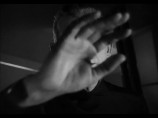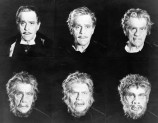A Masque of Madness (Notes on Film 06-B, Monologue 02)
80 min, 2013
Actor: Boris Karloff
Musik/Music: Johann Sebastian Bach
Sound: Christoph Amann
Übersetzung/Translation: C. B. Pfaffenbichler
Title Design: Nik Thoenen
de
Für Filmwissenschaftler Noël Burch beginnt die Filmgeschichte mit einem „Frankenstein’schen Traum“ der Verfügungsgewalt: Das Medium Film zerstückelt bewegtes Leben in tote Fragmente, um sie dann aus eigener Kraft neu zusammenzusetzen und zu reanimieren. Aus allen greifbaren Filmauftritten des Schauspielers Boris Karloff, berühmt geworden 1931 als Frankensteins Monster, hat nun Norbert Pfaffenbichler sein eigenes Found Footage-Ungetüm gebastelt. Wie schon im vorangegangenen Partnerfilm A Messenger from the Shadows (starring Lon Chaney) strahlt Pfaffenbichlers Re-Montage eines Filmlebens zu gleichen Maßen analytisches Interesse und tänzelnde Assoziationslust aus. Durch fünf Laufbild-Jahrzehnte Karloff – als Nebendarsteller im Stummfilm, Star im Tonfilm, Gastgeber im Fernsehen – zieht A Masque of Madness seine Pfade. In gebotener Pracht rafft der Film die immergleichen Rituale des Schauerkinos und Gesten exotischer Bedrohung. Aber er legt auch die Spuren frei, die Geschichte – zumal: zwei Weltkriege, und die technologischen Schübe in ihrem Windschatten – in ihnen hinterlassen hat.Mal um Mal muss Karloff hier den Frankenstein-Traum synthetischen Lebens durcharbeiten – als prometheischer Schöpfer und geknechtete Kreatur in Personalunion. So erzählt Pfaffenbichler nicht nur von der Karriere eines herausragenden Schauspielers, der seiner ikonischsten Schöpfung nie entkam, sondern eben auch von seinen eigenen Laborstudien zur Filmsyntax: Die Alchemie des continuity editing schafft ein Spiegelkabinett einander belauernder Karloffs, das so offenkundig widerlogisch wie visuell plausibel ist. Nach der Arbeit zum Stummfilmstar Chaney wird diesmal auch das Spiel mit dem Originalton auf vergnügliche Weise formgebend. Rhythmischer Schnitt lässt diverse Filmmaschinen miteinander musizieren und Frankensteins Monster zur Instrumentalbegleitung mehrerer Karloffs tanzen. „They won’t come to learn, only to stare“, klagt der mad scientist nach einem weiteren fürchterlichen Experiment. Die Trennung zwischen Staunen und Lernen lässt Pfaffenbichler aber auch in diesem Eintrag seiner Notes on Film entschieden hinter sich.
(Joachim Schätz)
“A Masque of Madness”: SIFF Review
John DeFore (The Hollywood Reporter)
en
For film scholar Noël Burch, film history begins with a “Frankenstein-like dream” of control: the film medium dismembers animated life into dead fragments to then assemble and reanimate them under its own power. Norbert Pfaffenbichler has put together his own found-footage monster from all of the accessible film appearances of the actor Boris Karloff, who rose to fame in 1931 as Frankenstein’s monster. As already in the previous partner work, A Messenger from the Shadows (starring Lon Chaney), Pfaffenbichler’s re-montage of a film life radiates both analytical interest and a nimble pleasure of association. A Masque of Madness follows the path through five motion picture decades of Karloff—as supporting actor in silent films, star in talking pictures, and television host. The film gathers, in the necessary glory, the ever same rituals of horror film and gestures of exotic danger. But it also exposes the tracks that history has left behind in them—especially the two world wars, and the technological advances.Time after time, Karloff has to work through the Frankenstein-dream of synthetic life—as Promethean creator and enslaved creature in one and the same person. In this way, Pfaffenbichler reports on not only the career of an outstanding actor, who never managed to escape his most iconic creation, but also his own lab studies on film syntax: The alchemy of continuity editing creates a mirrored gallery of Karloffs stalking one another, which is just as counter logical as it is visually plausible. After the work on silent movie star Chaney, in this film, also the play with the original sound is pleasurably shaping. Rhythmic cuts allow diverse film machines to make music with one another, and Frankenstein’s monster dance to the instrumental accompaniment of a host of Karloffs. “They won’t come to learn, only to stare,” complains the mad scientist after another horrific experiment. Also in this entry in his Notes on Film, Pfaffenbichler decidedly leaves behind the distinction between staring and learning.
(Joachim Schätz, Translation: Lisa Rosenblatt)
“My dear old monster, I owe everything to him. He’s my best friend”, actor Boris Karloff once quipped about his status as a horror icon, his star-making turn as the monster in James Whale Frankenstein (1931) followed by decades of mostly typecast, but brilliant performances. Aware of the irony, but also sincere in his tribute to the legendary actor, Austrian director Norbert Pfaffenbichler’s A Masque of Madness rearranges this career as a schizophrenic horror trip: Only Karloff appears in the images, interacting with himself—in all kinds of different masks and disguises, miraculously changing age, occasionally even race, language and gender! The second part of a diptych devoted to horror stars—the first was a silent made up from Lon Chaney’s surviving films—, A Masque of Madness is another major highlight in Pfaffenbichler’s Notes on Film cycle, a series of hugely entertaining and playfully profound found footage extravaganzas: Its own kind of often hilarious meta-horror-movie, in which the lonely star absurdly disintegrates in multitudes of his image(s), yet is unable to escape his cinematic destiny, while haunting impossible spaces created by the effortless recombination of half a century of film history.
Christoph Huber
“A Masque of Madness”: SIFF Review
John DeFore (The Hollywood Reporter)

